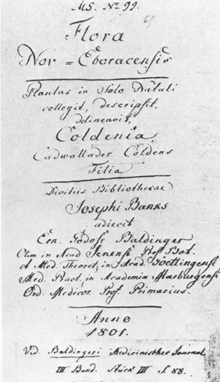Jane Colden
| Jane Colden | |
|---|---|

The title page added to Colden's manuscript in 1801 by Ernst Gottfried Baldinger
|
|
| Born |
March 27, 1724 New York City, New York |
| Died | March 10, 1766 (aged 41) |
| Occupation | Botanist |
| Known for | "the first woman in the New World to be distinguished as a botanist" |
| Spouse(s) | Dr. William Farquhar |
| Parent(s) |
|
Jane Colden (March 27, 1724 – March 10, 1766) was an American botanist, described as the "first botanist of her sex in her country" by Asa Gray in 1843. Although not acknowledged in botanical publications, she wrote a number of letters resulting in botanist John Ellis writing to Carl Linnaeus of her work applying the Linnaean system of plant identification to American flora, "she deserves to be celebrated". Contemporary scholarship maintains that she was the first female botanist working in America. She was regarded as a respected botanist by many prominent botanists such as: John Bartram, Peter Collinson, Alexander Garden, and Carl Linnaeus. Colden is most famous for her manuscript which remains titleless, in which she describes the flora of the New York area, and draws ink drawings of 340 different species of them.
Colden was born in New York City, the fifth child of Cadwallader Colden, who was a physician who trained at the University of Edinburgh and became involved in the politics and management of New York after arriving in the city from Scotland in 1718, and Alice Christy Colden, referred to as "the capable instructress of her children." She was educated at home and her father provided her with botanical training following the new system of classification developed by Carl Linnaeus. Of his daughter, Cadwallader wrote in a 1755 letter to Dr. John Frederic Gronovius that she possessed "a natural inclination to reading and a natural curiosity for natural philosophy and natural history." He wrote that Jane was already writing descriptions of plants using Linnaeus' classification and taking impressions of leaves using a press. In this letter, Cadwallader sought to gain her a position with Dr. Gronovius sending seeds or samples.
Between 1753 and 1758 Jane Colden catalogued New York's flora, compiling specimens and information on more than 300 species of plants from the lower Hudson River Valley, and classifying then according to the system developed by Linnaeus. She developed a technique for making ink impressions of leaves, and was also a skilled illustrator, doing ink drawings of 340. To many drawings she added pieces of folklore, suggesting medicinal uses for the plant. On January 20, 1756, Peter Collinson wrote to John Bartram that "Our friend Colden's daughter has, in a scientific manner, sent over several sheets of plants, very curiously anatomized after this [Linnaeus's] method. I believe she is the first lady that has attempted anything of this nature." In this instance Colden was recognized as what she is known today by the Dictionary of American Biography, the first female botanist in America. Colden participated in the Natural History Circle where she exchanged seeds and plants with other plant collectors in the American colonies and in Europe. These rounds with the Natural History Circle encouraged Jane to become a botanist. Through her father she met and corresponded with many leading naturalists of the time, including Carolus Linnaeus. One of her descriptions of a new plant, which she herself called Fibraurea, was forwarded to Linnaeus with the suggestion that he should call it Coldenella, but Linnaeus refused and called it Helleborus (now Coptis groenlandica).
...
Wikipedia
